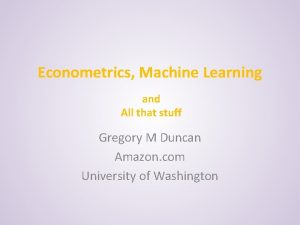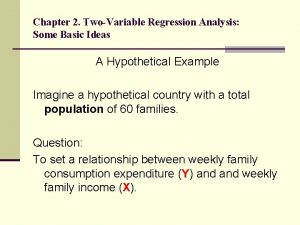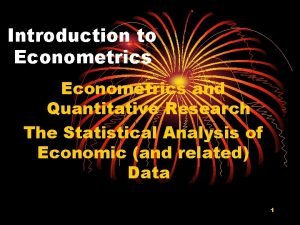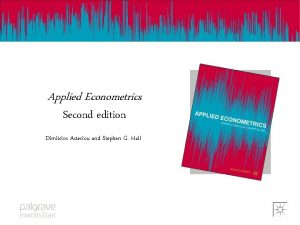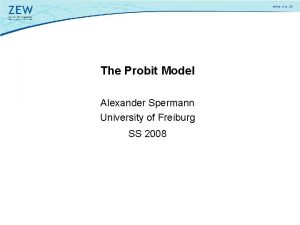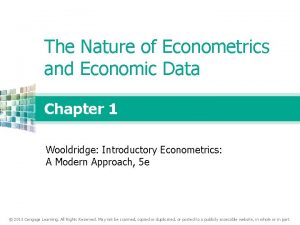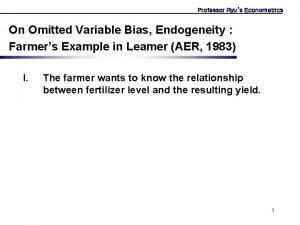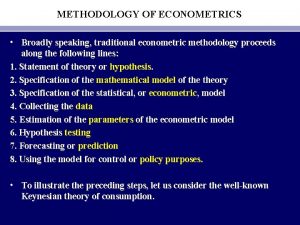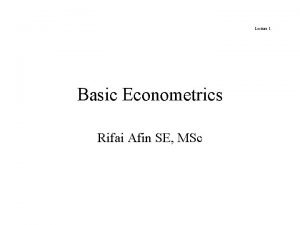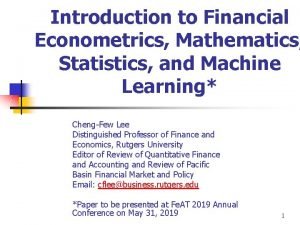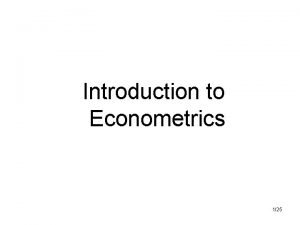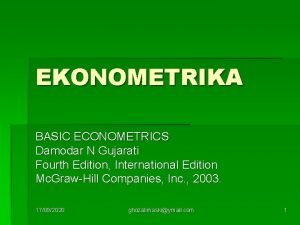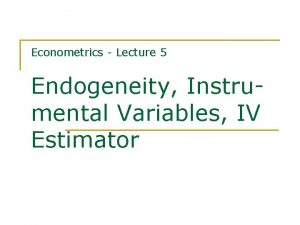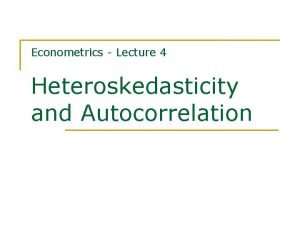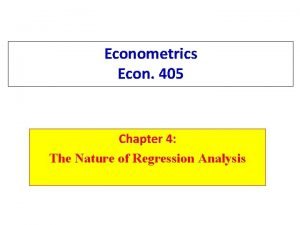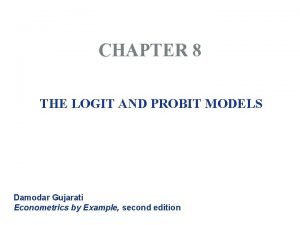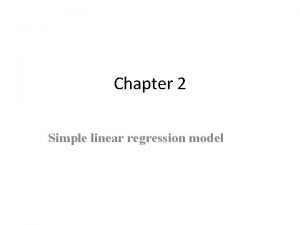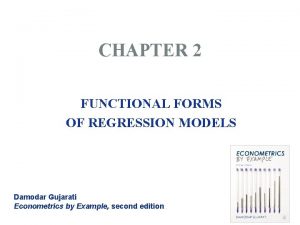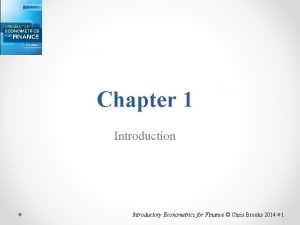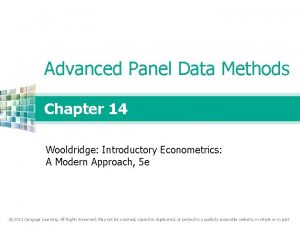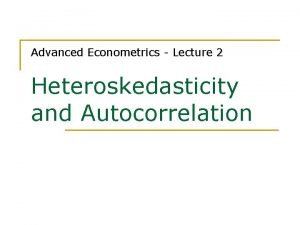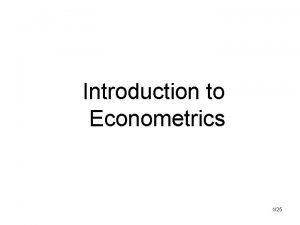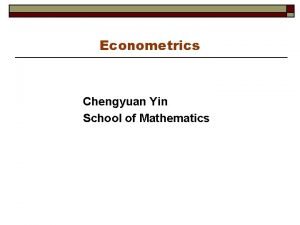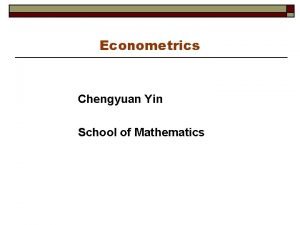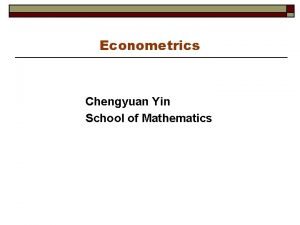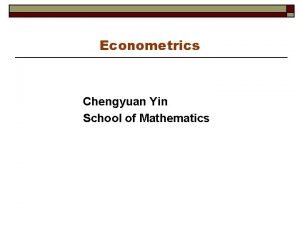Econometrics Machine Learning and All that stuff Gregory



















































- Slides: 51

Econometrics, Machine Learning and All that stuff Gregory M Duncan Amazon. com University of Washington

Introduction • Vast data available today – hundreds of billions of observations and millions of features – A 100, 000, 000 x 1, 500, 000 dimensional tables/matrices common • Allows analyses unthinkable 15 years ago • Presents challenges to econometricians, computer scientists and statisticians – How to get that matrix into a computer • Can you get that matrix into a computer – If so how do you interpret 1. 5 million independent variables • Can you interpret 1. 5 million independent variables 10/26/2020 San Francisco Federal Reserve 2017 2

Approaches • Very different approaches, and languages – Econometricians (and other social scientists) • What is the probability model for the data – Interested primarily in gaining insight into behavioral processes – Sometimes prediction – Statisticians • How to make inference for data from general probability models – Computer scientists • How to compute 10/26/2020 San Francisco Federal Reserve 2017 3

Culture Wars • Brieman(2000) – ML • How does the model predict out-of-sample • Proofs of properties more-or-less useless • Let data reveal structure – Statistics • What is the underlying probability model • How to infer structure • How to predict using structure – Economics • Much like Stat • Though economist and nearly as famous Economist Milton Friedman was clearly amenable to the ML camp • I would add Sims as well. 10/26/2020 San Francisco Federal Reserve 2017 4

Overview • Introduction to the intersection for economists. • Computer Science will tell you that they invented “big data” methods • Actually, a lot comes from economics This will be a theme. Much of the new stuff is quite old. Impossible to do in its day Made Possible by Advances in CS and Statistics 10/26/2020 San Francisco Federal Reserve 2017 5

Sidebar • Machine Learning is a chair with three legs – Statistics – Computer Science – Domain knowledge(Bio-Science, Econometrics) – Each group seems to give at best lip service to the others • Biotech has shown the way • Social Sciences and Statistics Lag 10/26/2020 San Francisco Federal Reserve 2017 6

Econometrics in Machine Learning • Causality and identification – Economics 1950 • Leonid Hurwicz (Economics 2007, Nobel Prize winner)(U Minnesota) – Computer Science 1998 • Judea Pearl (UCLA) • Tree methods – Economics 1963 • James N. Morgan (U of Michigan) – Statistics 1984 • Leo Brieman (Berkeley) • Map Reduce – Economics 1980 • Me (Northwestern) – Computer Science 2004 • Jeffrey Dean and Sanjay Ghemawat (Google) 10/26/2020 San Francisco Federal Reserve 2017 7

Econometrics in Machine Learning • Bagging/Ensemble Methods – Economics 1969 • Bates and Granger (UCSD) – ML 1996 • Brieman (almost of course) • Economists early contributors to neural net/deep learning literature (late 1980’s early 1990’s) – Hal White, Jeff Wooldridge, Ron Gallant, Max Stinchcombe – Quantile neural nets, learning derivatives, guarantees for convergence, distributions etc. • Needed for counterfactuals when out of sample validation make no conceptual sense 10/26/2020 San Francisco Federal Reserve 2017 8

• Much of machine learning – rediscovers old statistical and econometric methods – but making them blindingly fast and practicable This is not damning with faint praise • Many of the tools used today have been enabled purely by computers – Bootstrap (1984) • resampling – SAS (1966, but really 1976) • Huge datasets – TSP (1966) • UI – Albeit command line – Principled Model Selection (Lasso, L 2 -boosting) 10/26/2020 San Francisco Federal Reserve 2017 9

• Outcome of machine learning is generally a data reduction – Regression coefficients – Summary statistics – A prediction • Machine learning allows more complex models than economists are used to • I will focus on regression-like tools 10/26/2020 San Francisco Federal Reserve 2017 10

Regression Setup • 10/26/2020 San Francisco Federal Reserve 2017 11

ML Approach • ML would use – GLMs – Neural Nets – Support Vector Machines – Boosting – Regularization methods • Ridge • Lasso • Elastic Net – Classification and regression trees (CART) – Random forests 10/26/2020 San Francisco Federal Reserve 2017 12

• I will concentrate on the last 4 • In all 4 of these, the ML goal is getting good out-of-sample predictions – Good for their own sake • ML believes good-out-of-sample predictions imply – a implicit consistent estimate of the underlying data generation process 10/26/2020 San Francisco Federal Reserve 2017 13

First ML Problem: Overfitting • It is quite easy to obtain models that give nearly perfect in-sample predictions • But the model fails disastrously out of sample. • This is referred to as overfitting • ML has developed a number of incredibly useful methods for handling overfitting. • One such is 10/26/2020 San Francisco Federal Reserve 2017 14

Out of Sample Validation • Divide data into subsets for the purpose of estimation, testing and validation • Training data used to estimate • Estimated model predicts on the validation set and compared to actual. • Similarly for testing. – Economists have taught this for years – Few if any ever did it • Too little data • Another such is 10/26/2020 San Francisco Federal Reserve 2017 15

Regularization • 10/26/2020 San Francisco Federal Reserve 2017 16

• 10/26/2020 San Francisco Federal Reserve 2017 17

Or • 402, 387, 260, 077, 093, 773, 543, 702, 433, 923, 003, 985, 719, 374, 864, 210, 714, 632, 543, 799, 910, 429, 938, 512, 398, 629, 020, 592, 044, 208, 486, 969, 404, 800, 479, 988, 610, 197, 196, 058, 631, 666, 872, 994, 808, 558, 901, 323, 829, 669, 944, 590, 997, 424, 504, 087, 073, 759, 918, 823, 627, 727, 188, 732, 519, 779, 505, 950, 995, 276, 120, 874, 975, 462, 497, 043, 601, 418, 278, 094, 646, 496, 291, 056, 393, 887, 437, 886, 487, 337, 119, 181, 045, 825, 783, 647, 849, 977, 012, 476, 632, 889, 835, 955, 735, 432, 513, 185, 323, 958, 463, 075, 557, 409, 114, 262, 417, 474, 349, 347, 553, 428, 646, 576, 611, 667, 797, 396, 668, 820, 291, 207, 379, 143, 853, 719, 588, 249, 808, 126, 867, 838, 374, 559, 731, 746, 136, 085, 379, 534, 524, 221, 586, 593, 201, 928, 090, 878, 297, 308, 431, 392, 844, 403, 281, 231, 558, 611, 036, 976, 801, 357, 304, 216, 168, 747, 609, 675, 871, 348, 312, 025, 478, 589, 320, 767, 169, 132, 448, 426, 236, 131, 412, 508, 780, 208, 000, 261, 683, 151, 027, 341, 827, 977, 704, 784, 635, 868, 170, 164, 365, 024, 153, 691, 398, 281, 264, 810, 213, 092, 761, 244, 896, 359, 928, 705, 114, 964, 975, 419, 909, 342, 221, 566, 832, 572, 080, 821, 333, 186, 116, 811, 553, 615, 836, 546, 984, 046, 708, 975, 602, 900, 950, 537, 616, 475, 847, 728, 421, 889, 679, 646, 244, 945, 160, 765, 353, 408, 198, 901, 385, 442, 487, 984, 959, 953, 319, 101, 723, 355, 556, 602, 139, 450, 399, 736, 280, 750, 137, 837, 615, 307, 127, 761, 926, 849, 034, 352, 625, 200, 015, 888, 535, 147, 331, 611, 702, 103, 968, 175, 921, 510, 907, 788, 019, 393, 178, 114, 194, 545, 257, 223, 865, 541, 461, 062, 892, 187, 960, 223, 838, 971, 476, 088, 506, 276, 862, 967, 146, 674, 697, 562, 911, 234, 082, 439, 208, 160, 153, 780, 889, 893, 964, 518, 263, 243, 671, 616, 762, 179, 168, 909, 779, 911, 903, 754, 031, 274, 622, 289, 988, 005, 195, 444, 414, 282, 012, 187, 361, 745, 992, 642, 956, 581, 746, 628, 302, 955, 570, 299, 024, 324, 153, 181, 617, 210, 465, 832, 036, 786, 906, 117, 260, 158, 783, 520, 751, 516, 284, 225, 540, 265, 170, 483, 304, 226, 143, 974, 286, 933, 061, 690, 897, 968, 482, 590, 125, 458, 327, 168, 226, 458, 066, 526, 769, 958, 652, 682, 272, 807, 075, 781, 391, 858, 178, 889, 652, 208, 164, 348, 344, 825, 993, 266, 043, 367, 660, 176, 999, 612, 831, 860, 788, 386, 150, 279, 465, 955, 131, 156, 552, 036, 093, 988, 180, 612, 138, 558, 600, 301, 435, 694, 527, 224, 206, 344, 631, 797, 460, 594, 682, 573, 103, 790, 084, 024, 432, 438, 465, 657, 245, 014, 402, 821, 885, 252, 470, 935, 190, 620, 929, 023, 136, 493, 273, 497, 565, 513, 958, 720, 559, 654, 228, 749, 774, 011, 413, 346, 962, 715, 422, 845, 862, 377, 387, 538, 230, 483, 865, 688, 976, 461, 927, 383, 814, 900, 140, 767, 310, 446, 640, 259, 899, 490, 222, 221, 765, 904, 339, 901, 886, 018, 566, 526, 485, 061, 799, 702, 356, 193, 897, 017, 860, 040, 811, 889, 729, 918, 311, 021, 171, 229, 845, 901, 641, 921, 068, 884, 387, 121, 855, 646, 124, 960, 798, 722, 908, 519, 296, 819, 372, 388, 642, 614, 839, 657, 382, 291, 123, 125, 024, 186, 649, 353, 143, 970, 137, 428, 531, 926, 649, 875, 337, 218, 940, 694, 281, 434, 118, 520, 158, 014, 123, 344, 828, 015, 051, 399, 694, 290, 153, 483, 077, 644, 569, 099, 073, 152, 433, 278, 288, 269, 864, 602, 789, 864, 321, 139, 083, 506, 217, 095, 002, 597, 389, 863, 554, 277, 196, 742, 822, 248, 757, 586, 765, 752, 344, 220, 207, 573, 630, 569, 498, 825, 087, 968, 928, 162, 753, 848, 863, 396, 909, 959, 826, 280, 956, 121, 450, 994, 871, 701, 244, 516, 461, 260, 379, 029, 309, 120, 889, 086, 942, 028, 510, 640, 182, 154, 399, 457, 156, 805, 941, 872, 748, 998, 094, 254, 742, 173, 582, 401, 063, 677, 404, 595, 741, 785, 160, 829, 230, 135, 358, 081, 840, 096, 996, 372, 524, 230, 560, 855, 903, 700, 624, 271, 243, 416, 909, 004, 153, 690, 105, 933, 983, 835, 777, 939, 410, 970, 027, 753, 472, 000, 000, 000, 000, 000, 000, 000, 000, 000, 000, 000, 000, 000, 000, 000, 000, 000, 000, 000, 000, 000 • Whack off 7 of the zeros and divide by three to get the number of years to use Mallows method in a small ML problem 10/26/2020 San Francisco Federal Reserve 2017 18

Lasso • 10/26/2020 San Francisco Federal Reserve 2017 19

Cross validation • 10/26/2020 San Francisco Federal Reserve 2017 20

The test-train-cross validate paradigm is a key contribution of ML to econometrics 10/26/2020 San Francisco Federal Reserve 2017 21

Oracle Property • In using some big data procedures one does not need to account for estimating the tuning parameter. • One may proceed as though the parameter were known. • Key requirement seems to be • number of possible features is large • But only a small number can matter. – Can even have more explanatory variables than observations! 10/26/2020 San Francisco Federal Reserve 2017 22

ols after lasso • Belloni and Chernozhukov in 2013 showed that ordinary least squares after lasso has the (near) oracle property: – The lasso finds the features with non-zero coefficients – Using these features in a subsequent ordinary least squares requires no adjustment for the lasso • Nor does the lasso need account for the fact that the tuning parameter was estimated. 10/26/2020 San Francisco Federal Reserve 2017 23

Trees and Forests: Increasing Complexity by Decreasing It • 10/26/2020 San Francisco Federal Reserve 2017 24

• But we don’t know the regions. – So find them by searching • As stated, this problem is too hard to solve – Typically need at least 5 observations in a region – How many possible 5 observation regions are there with N observations with p (say 1000) independent variables? • I would not know how to even approach the counting problem • SO we solve a simpler one using simple regions defined recursively • Brings us to the second ML method we will discuss 10/26/2020 San Francisco Federal Reserve 2017 25

Forests and Trees: Trees(CART) • For each independent variable – split range into two regions, • Calculate mean and sum of squares of Y in each region. • Split point minimizes the SSR of Y in the two regions – (best fit) • Choose the variable to split on as the one with the lowest SSR • Both of these regions are split into two more regions, • this process is continued, until some stopping rule is applied. – The split points are called nodes – The end points are called leaves • Stop splitting a leaf if – all the values in the leaf are the same – the number of branches exceeds some tuning parameter – the tree gets too complex by some criteria • Quit when no leaves can be split. 10/26/2020 San Francisco Federal Reserve 2017 26

Example: Pima Indian Diabetes Study • • The binary-valued variable tested positive for diabetes The population lives near Phoenix, Arizona, USA. Number of Instances: 768 Number of Attributes: 8 plus class 1. Npreg. Number of times pregnant 2. Glucose. Plasma glucose concentration a 2 hours in an oral glucose tolerance test 3. Diastolic blood pressure (mm Hg) 4. TSFTriceps skin fold thickness (mm) 5. Insulin 2 -Hour serum insulin (mu U/ml) 6. BMIBody mass index (weight in kg/(height in m)^2) 7. DPFDiabetes pedigree function 8. Age (years) 9. Class variable (0 or 1) (class value 1 is interpreted as "tested positive for diabetes") Class Value Number of instances 0 500 1 268 10/26/2020 San Francisco Federal Reserve 2017 27

Glucose <127. 5 BMI<29. 95 Age<28. 5 GL<145. 5 BMI<26. 35 0 (245/23) 0 (39/2) 0(35/6) Gl<99. 5 0 45/10 0 (13/8) DPF<. 561 DPF<. 2 Insulin<14. 5 1 (4/10) 1/(9/25) GL<157. 5 0 (17/4) Age<30. 5 0 (28/12) 1(2/9) 1 (18/47) 1 (3/9) BMI<41. 8 0 (27/7) 1 (12/80) 1 (0/10) 1 (3/6) PIMA Indian Diabetes Study 10/26/2020 San Francisco Federal Reserve 2017 28

Problems • Overfitting – Horrid out of sample accuracy • What tuning parameters to use – How complex a tree, how deep • Huge literature on what to do – Not very persuasive • Legitimate researchers of good will using acceptable criteria would come up with VERY different answers. 10/26/2020 San Francisco Federal Reserve 2017 29

Rescue 1: Boosting • Train a model • Train a second model – Probably, you’ll see error decrease. • Continue m=2, . . , M • Stop when sufficient accuracy is achieved. • Questions: what to use for a loss function, what to use for the h, what to use for the η, stopping. 10/26/2020 San Francisco Federal Reserve 2017 30

Gradient Boosting • Input training set • a piecewise-differentiable loss function – Squared loss, quantile loss, a (negative) likelihood (cross entropy loss) • number of iterations M. 10/26/2020 San Francisco Federal Reserve 2017 31

Gradient Boosting • Initialize model with a constant value: • For m = 1 to M: – Compute so-called pseudo-residuals – Fit a base learner (e. g. tree) to pseudo-residuals, i. e. train it using the training set. – Compute multiplier • Like step size in gradient search – Update the model – Output 10/26/2020 San Francisco Federal Reserve 2017 32

Boosting Can Be Used For Model Selection • Target y and features x 1, …, xm • Normalized and standardized • Until change in MSE between iterations is small – Regress each x on y choose the x with the highest absolute correlation (coefficient) to add to a set of final features, Z – Regress y on the x in Z and the residual becomes the new y – Repeat • Correctly done the process, l 2 boosting, has the oracle property. • The final regression of y on the elements of Z is “correct”. 10/26/2020 San Francisco Federal Reserve 2017 33

Boosting Rarely Overfits Repeat!! Boosting Rarely Overfits 10/26/2020 San Francisco Federal Reserve 2017 34

Rescue 2: Random Forests • Brieman (2001) • Simple trees: – if independent and unbiased – average would be unbiased and have a small variance. • Called ensemble learning – averaging over many small models tends to give better out-ofsample prediction than choosing a single complicated model. • New insight for ML/Statistics • Economists have done this for years – We call it model averaging • Primarily in macro modeling – Bates and Granger (1969) – Granger and Ramanathan (1984) 10/26/2020 San Francisco Federal Reserve 2017 35

Random Forest Details • For b = 1 to B: – Draw N bootstrap observationsfrom the training data. – Grow a single tree T(b) from the bootstrapped data • repeat the following steps for each node, until minimum node size nmin – Select m variables at random from the p variables. – Pick the best variable/split-point among the m. – Split the node into two daughter nodes. • The output of tree is average of the y in the regression case or a 0/1 for classification. 10/26/2020 San Francisco Federal Reserve 2017 36

Random Forest Details • 10/26/2020 San Francisco Federal Reserve 2017 37

Problem with Both • Random Forests and Boosted regressions • Give astoundingly good predictions – BUT – yield little insight into data generation mechanism • There is a trade-off between accuracy (coming from more flexibility) and interpretability. – Linear regressions are interpretable but inflexible – RF and BF flexible, accurate but uninterpretable 10/26/2020 San Francisco Federal Reserve 2017 38

Another Problem. Which Method To Use • We don’t know • There is a theorem that says we can’t know • It is an appropriate Theorem for a group of Economists at a meal • It is The No Free Lunch Theorem 10/26/2020 San Francisco Federal Reserve 2017 39

no-free-lunch theorems • There cannot be a universal learner. – Wolpert and Macready (1995 -2005) • without priori knowledge about process or mechanism you are just guessing • Economics has known for a long time – ML has come to agree • prior knowledge is a necessary requirement for successful learning. • There are no-free-lunches 10/26/2020 San Francisco Federal Reserve 2017 40

Second ML Problem • Causality: A Separate Talk but here is the issue – Your perfect AI/ML model predicts 3% revenue decline next month • No kudos from management for perfection – Just two questions WHY? And WHAT CAN WE DO ABOUT IT? 10/26/2020 San Francisco Federal Reserve 2017 41

The Causal Counterfactual Challenge • These require causal and counterfactual models • ML models not designed for these • Problem 1 – Can’t do out-of-sample cross validation • Problem 2 – Best predictive models uninterpretable • Correlation isn’t enough 10/26/2020 San Francisco Federal Reserve 2017 42

The Causal Counterfactual Challenge • Height and weight highly correlated – Dieting doesn’t make you shorter • City altitude and average temperature highly negatively correlated – Putting heaters in all homes – Or global warming – Won’t decrease altitude • New models required • Some effort here – Athey, Imbens, Pearl, Jantzig, Schölkopf, Wager among others – Lots of work needed 10/26/2020 San Francisco Federal Reserve 2017 43

The Causal Counterfactual Challenge • Economists have contributed lots of work on the identification side starting with Reirosol, Marschak and Hurwicz. • More recently Chesher, Chernozhukov, Matzkin, Newey 10/26/2020 San Francisco Federal Reserve 2017 44

The End 10/26/2020 San Francisco Federal Reserve 2017 45

References of Particular Interest Breiman, L. , (2001), Statistical Modeling: The Two Cultures (with comments and a rejoinder by the author), Statistical Science, Volume 16, Issue 3 (2001), 199 -231. https: //projecteuclid. org/euclid. ss/1009213726 Efron, B. , and Trevor Hastie (2016). Computer Age Statistical Inference: Algorithms, Evidence, and Data Science (Institute of Mathematical Statistics Monographs). Cambridge: Cambridge University Press. https: //web. stanford. edu/~hastie/CASI/ Donoho, David (2015) 50 years of Data Science. Tukey Centennial Workshop, Princeton NJ Sept 18 2015. http: //pages. cs. wisc. edu/~anhai/courses/784 -fall 15/50 Years. Data. Science. pdf James, Gareth, Daniela Witten, Trevor Hastie and Robert Tibshirani (2015) An Introduction to Statistical Learning, with Applications in R, Springer. http: //www-bcf. usc. edu/~gareth/ISLR%20 Sixth%20 Printing. pdf Harry J. Paarsch and Konstantin Golyaev (2016) A Gentle Introduction to Effective Computing in Quantitative Research: What Every Research Assistant Should Know, MIT Press. Peters, Jonas, Dominik Janzing, and Bernhard Schölkopf(2017) Elements of Causal Inference: Foundations and Learning Algorithms, MIT Press John W Tukey (1962) The future of data analysis. The Annals of Mathematical Statistics, 1– 67. https: //projecteuclid. org/download/pdf_1/euclid. aoms/1177704711 10/26/2020 San Francisco Federal Reserve 2017 46

References Angrist , J. and Alan B. Krueger, (2001) Instrumental Variables and the Search for Identification: From Supply and Demand to Natural Experiments, Journal of Economic Perspectives –Vol. 15, 69 -85 Angrist, J. , Imbens, G. , and Rubin, D. , (1996) Identification of Causal effects Using Instrumental Variables, Journal of the American Statistical Association. Angrist, Joshua D. and Jörn-Steffen Pischke, (2008) Mostly Harmless Econometrics, Princeton University Press Bates, J. , and C. Granger (1969), The Combination of Forecasts, Operations Research Quarterly, 20, 451 -468. Berk, Richard A. , (2009) Statistical Learning from a Regression Perspective, Springer Belloni, Alexandre and Victor Chernozhukov (2013) Least squares after model selection in high-dimensional sparse models, Bernoulli 19(2), 521– 547 DOI: 10. 3150/11 -BEJ 410 Breiman, L. , (1996) Bagging Predictors, Machine Learning, 24(2), pp. 123 -140. Breiman, L. , (2001), Statistical Modeling: The Two Cultures (with comments and a rejoinder by the author), Statistical Science, Volume 16, Issue 3 (2001), 199 -231. Breiman, L. , J. H. Friedman, R. A. Olshen, and C. J. Stone (1984) Classication and Regression Trees. Wadsworth and Brooks/Cole, Monterey. Blundell, Richard; Matzkin, Rosa L. (2013) Conditions for the existence of control functions in nonseparable simultaneous equations models, http: //www. ucl. ac. uk/~uctp 39 a/Blundell_Matzkin_June_23_2013. pdf Blundell R. W. & J. L. Powell (2003) Endogeneity in Nonparametric and Semiparametric Regression Models. In Dewatripont, M. , L. P. Hansen, and S. J. Turnovsky, eds. , Advances in Economics and Econometrics: Theory and Applications, Eighth World Congress, Vol. II. Cambridge: Cambridge University Press. 10/26/2020 San Francisco Federal Reserve 2017 47

References Blundell, R. W. & J. L. Powell (2004) Endogeneity in Semiparametric Binary Response Models. Review of Economic Studies 71, 655 -679. Chesher, A. D. (2005) Nonparametric Identification under Discrete Variation Econometrica 73, 1525 -1550. Chesher, A. D. (2007) Identification of Nonadditive Structural Functions. In R. Blundell, T. Persson and W. Newey, eds. , Advances in Economics and Econometrics, Theory and Applications, 9 th World Congress, Vol III. Cambridge: Cambridge University Press. Chesher, A. D. (2010) Instrumental Variable Models for Discrete Outcomes. Econometrica 78, 575 -601. Donoho, David (2015) 50 years of Data Science. Tukey Centennial Workshop, Princeton NJ Sept 18 2015, http: //pages. cs. wisc. edu/~anhai/courses/784 -fall 15/50 Years. Data. Science. pdf Duncan, Gregory M. (1980) Approximate Maximum Likelihood with Datasets That Exceed Computer Limits, Journal of Econometrics 14 257 -264. Einav, Liran and Jonathan Levin. The data revolution and economic analysis (2013) NBER Innovation Policy and the Economy Conference, 2013. Friedman, Jerome and Bogdan E. Popescu (2005) Predictive learning via rule ensembles. Technical report, Stanford University http: //www-stat. stanford. edu/~jhf/R-Rule. Fit. html Friedman, Jerome and Peter Hall (2005) On bagging and nonlinear estimation. Technical report, Stanford University, http: //www-stat. stanford. edu/~jhf/ftp/bag. pdf Friedman, Jerome (1999) Stochastic gradient boosting. Technical report, Stanford University. http: //wwwstat. stanford. edu/~jhf/ftp/stobst. pdf 10/26/2020 San Francisco Federal Reserve 2017 48

References Haavelmo, T. (1943). "The Statistical Implications of a System of Simultaneous Equations". Econometrica, Vol. 11, 1– 12. Haavelmo, T. (1944). "The Probability Approach in Econometrics" Econometrica, Vol. 12, Supplement, iii-115 Hastie, Trevor, Robert Tibshirani, and Jerome Friedman (2009) The Elements of Statistical Learning: Data Mining, Inference, and Prediction. Springer-Verlag, 2 ed http: //wwwstat. stanford. edu/~tibs/Elem. Stat. Learn/download. html Heckman James J. (2010) Building Bridges Between Structural and Program Evaluation Approaches to Evaluating Policy, Journal of Economic Literature, Vol. 48, No. 2 Heckman, J. J. (2008) Econometric Causality. International Statistical Review, Vol. 76, 1 --27. Heckman, J. J. , (2005) The scientific model of causality, Sociological Methodology, Vol. 35, 1 -97. Heckman, James J. and Rodrigo Pinto (2012) Causal Analysis After Haavelmo: Definitions and a Unified Analysis of Identification of Recursive Causal Models, Causal Inference in the Social Sciences, University of Michigan Hendry, David F. and Hans-Martin Krolzig(2004) We ran one regression. Oxford Bulletin of Economics and Statistics, 66(5): 799 -810 Holland, Paul W. , (1986) Statistics and Causal Inference, Journal of the American Statistical Association, Vol. 81, No. 396. , pp. 945– 960 10/26/2020 San Francisco Federal Reserve 2017 49

References Hurwicz, L. (1950) Generalization of the concept of identification. In Statistical Inference in Dynamic Economic Models (T. Koopmans, ed. ). Cowles Commission, Monograph 10, Wiley, New York, 245– 257. James, Gareth, Daniela Witten, Trevor Hastie, and Robert Tibshirani (2013) An Introduction to Statistical Learning with Applications in R. Springer, New. York. Mallows, C. L. (1964). Choosing Variables In A Linear Regression: A Graphical Aid. Presented at the Central Regional Meeting of the Institute of Mathematical Statistics, Manhattan, Kansas, May 7 -9. Marschak, J. (1950) Statistical inference in economics: An introduction. In T. C. Koopmans, editor, Statistical Inference in Dynamic Economic Models, pages 1– 50. Cowles Commission for Research in Economics, Monograph No. 10. Morgan, James N. and John A. Sonquist (1963) Problems in the analysis of survey data, and a proposal. Journal of the American Statistical Association, 58(302): 415 -434. URL http: //www. jstor. org/stable/2283276. Morgan, Stephen L. and Christopher Winship, (2007) Counterfactuals and Causal Inference: Methods and Principles for Social Research, Cambridge University Press Neyman, Jerzy. (1923) Sur les applications de la theorie des probabilites aux experiences agricoles: Essai des principes. Master's Thesis (1923). Excerpts reprinted in English, Statistical Science, Vol. 5, pp. 463 -472. Pearl, J. , (2000) Causality: Models, Reasoning, and Inference, Cambridge University Press. Pearl, J. , (2009) Causal inference in statistics: An overview, Statistics Surveys, Vol. 3, 96 -146. Reiersol, Olav. (1941) Confluence Analysis by Means of Lag Moments and Other Methods of Confluence Analysis, Econometrica , Vol. 9, 1 -24. Rubin, Donald (1974) Estimating Causal Effects of Treatments in Randomized and Nonrandomized Studies, Journal of Educational Psychology, 66 (5), pp. 688– 701. Rubin, Donald (1978) Bayesian Inference for Causal Effects: The Role of Randomization, The Annals of Statistics, 6, pp. 34– 58. Rubin, Donald (1977) Assignment to Treatment Group on the Basis of a Covariate, Journal of Educational Statistics, 2, pp. 1– 26. 10/26/2020 San Francisco Federal Reserve 2017 50

References Shpitser, I. and Pearl, J. , (2006) Identification of Conditional Interventional Distributions. In R. Dechter and T. S. Richardson (Eds. ), Proceedings of the Twenty-Second Conference on Uncertainty in Artificial Intelligence, Corvallis, OR: AUAI Press, 437 -444. Wu, Xindong and Vipin Kumar, editors. The Top Ten Algorithms in Data Mining. CRC Press, 2009. URL http: //www. cs. uvm. edu/~icdm/algorithms/index. shtml 10/26/2020 San Francisco Federal Reserve 2017 51
 Econometrics machine learning
Econometrics machine learning Phân độ lown ngoại tâm thu
Phân độ lown ngoại tâm thu Block av độ 2
Block av độ 2 Thơ thất ngôn tứ tuyệt đường luật
Thơ thất ngôn tứ tuyệt đường luật Thơ thất ngôn tứ tuyệt đường luật
Thơ thất ngôn tứ tuyệt đường luật Chiến lược kinh doanh quốc tế của walmart
Chiến lược kinh doanh quốc tế của walmart Tìm vết của đường thẳng
Tìm vết của đường thẳng Con hãy đưa tay khi thấy người vấp ngã
Con hãy đưa tay khi thấy người vấp ngã Tôn thất thuyết là ai
Tôn thất thuyết là ai Gây tê cơ vuông thắt lưng
Gây tê cơ vuông thắt lưng Sau thất bại ở hồ điển triệt
Sau thất bại ở hồ điển triệt Inductive vs analytical learning
Inductive vs analytical learning Combining inductive and analytical learning
Combining inductive and analytical learning Eager learner and lazy learner
Eager learner and lazy learner Concept learning task in machine learning
Concept learning task in machine learning Analytical learning in machine learning
Analytical learning in machine learning Pac learning model in machine learning
Pac learning model in machine learning Pac learning model in machine learning
Pac learning model in machine learning Instance based learning in machine learning
Instance based learning in machine learning Inductive learning machine learning
Inductive learning machine learning First order rule learning in machine learning
First order rule learning in machine learning Deep learning vs machine learning
Deep learning vs machine learning Name all the rays
Name all the rays Cuadro comparativo de e-learning b-learning y m-learning
Cuadro comparativo de e-learning b-learning y m-learning Nature and scope of managerial economics
Nature and scope of managerial economics Worthless regression chapter 2
Worthless regression chapter 2 Econometrics and quantitative economics
Econometrics and quantitative economics Applied econometrics dimitrios asteriou
Applied econometrics dimitrios asteriou Spoken poetry english
Spoken poetry english Moore and mealy machine
Moore and mealy machine Differentiate between simple machine and compound machine
Differentiate between simple machine and compound machine Probit model
Probit model Nature of econometrics
Nature of econometrics Confidence interval econometrics
Confidence interval econometrics Endogeneity econometrics
Endogeneity econometrics Dataset for multiple regression
Dataset for multiple regression Gujarati econometrics
Gujarati econometrics Methodology of econometrics
Methodology of econometrics Methodology of econometrics
Methodology of econometrics Financial econometrics
Financial econometrics Methodology of econometrics
Methodology of econometrics Ekonometrika gujarati
Ekonometrika gujarati Endogeneity econometrics
Endogeneity econometrics Autocorrelation in econometrics
Autocorrelation in econometrics Srf in econometrics
Srf in econometrics Probit econometrics
Probit econometrics Autocorrelation ppt gujarati
Autocorrelation ppt gujarati Prf in econometrics
Prf in econometrics Functional form of regression model
Functional form of regression model Introduction to econometrics for finance
Introduction to econometrics for finance Wooldridge econometrics slides
Wooldridge econometrics slides Autocorrelation in econometrics
Autocorrelation in econometrics
